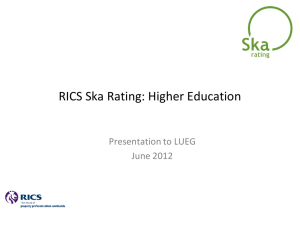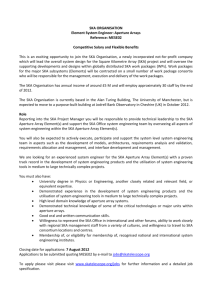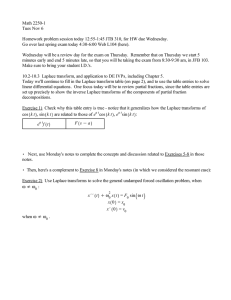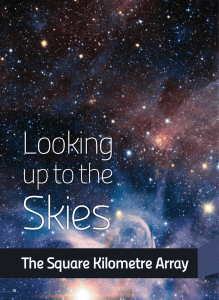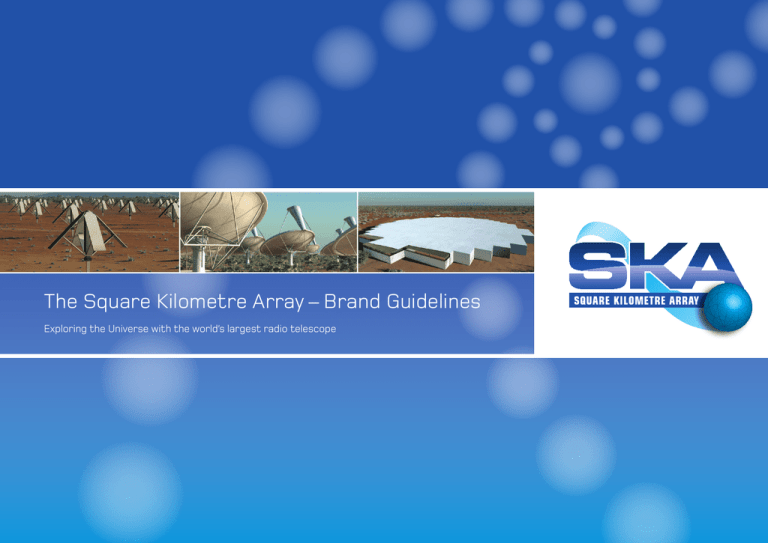
The Square Kilometre Array – Brand Guidelines
Exploring the Universe with the world’s largest radio telescope
Introduction / Brand Strategy
Page 03
Brand Mark / Primary Logo
Page 05
Secondary Logo
Page 06
Colour usage
Page 07
Typography
Page 08
The Spiral Graphic
Page 09
Graphs and Diagrams
Page 10
Imagery
Page 11
Examples of communication
Page 12
SKA Strategy
Page 21
Contacts
Page 22
© 2011 Carbon Creative Ltd - All rights reserved www.carboncreative.net
02
Introduction
The Square Kilometre Array
Who are we?
The Square Kilometre Array (SKA) is a proposed
radio telescope that, when built will be the largest,
and most sensitive radio telescope in the world,
and will be able to scan the skies faster than any
other telescope. It will be able to look back in
time to explore the beginnings of the Universe
and its ultimate fate. The SKA will be made up of
thousands of radio wave receptors, linked together
across an area the size of an entire continent.
The SKA will be based in either Southern Africa or
Australia – New Zealand; a decision on the site will
be made in 2012. The SKA is a non-profit making
organisation made of astronomers and engineers
from collaborating Universities and research
institutes in 20 different countries. Completion of
the telescope is scheduled for 2024.
The SKA will answer five main questions:
[ How were the first black holes and stars formed?
[ How do galaxies evolve and what is dark energy?
[ Was Einstein right about gravity?
[ What forms giant magnetic fields in space?
However the SKA has the potential to make
discoveries that we can’t even imagine today.
Project values
The project is funded with public money and
therefore fosters an open and transparent
approach to information management. Information
is made freely available on the website and
non-technical explanations are given so that
the project is easily understandable to nonastronomers.
[ Are we alone in the Universe?
Brand Strategy
The tone of the SKA brand should be primarily technical and professional. It
should have a clean, clear, un-cluttered, business-like look whilst still conveying
the exciting and inspirational nature of the project.
03
The Square Kilometre Array - Brand guidelines
© 2011 Carbon Creative Ltd - All rights reserved www.carboncreative.net
04
Dimensional usage
Colour usage
Our logo is the most important asset
to our brand image. Its usage should
be clear, concise and never cluttered
by surrounding imagery.
The logo has been designed for
consistent colour reproduction.
The logo is best reproduced out of
industry standard Pantone Matching
System inks.
The logo should never be changed or
altered in any form. It should not be
recreated, scanned or reproduced
unless we grant permission otherwise.
Master Logo: full colour
Exclusion Zone
Pantone Reflex Blue
C100 M73 Y0 K2, R0 G84 B164
This specifies the space around the logo that should remain free of
imagery and/or typography. It is the minimum space around the logo. The
area can be allocated with half of the globe device taken from the logo
as illustrated above.
X use on colour block
X rotate the logo
X recolour the logo
Size & Scale
The logo should never be reproduced smaller
than 35mm wide for print purposes or 100
pixels wide for multimedia usage. If re-sizing
the scaling must remain proportional and
equal to the original, stretching of the logo
is not permitted.
05
The Square Kilometre Array - Brand guidelines
SQUARE KILOMETRE ARRAY
Single Colour Logo: greyscale
35mm
The primary colours are:
Process Cyan
C100 M0 Y0 K0, R0 G174 B239
X use against photo
X change logo elements
X stretch the logo
CMYK full colour reproduction of the
logo is also acceptable, colour shifts
in this process should be considered.
For single colour printing refer to the
logo variant.
© 2011 Carbon Creative Ltd - All rights reserved www.carboncreative.net
06
Alternative logo use
A second iteration of the logo exists for
printed and online materials. This should
be selected for use against coloured
backgrounds for example. Similar
exclusion zone rules apply, however
please note the rules regarding size and
scale for print and digital mediums.
Foundry Monoline Bold - Used for main headings and key messages
ABCDEFGHIJKLMNOPQRSTUVWXYZ
abcdefghijklmnopqrstuvwxyz
1234567890?&$£!%/.,()@
Foundry Monoline Medium - Used for sub-headings
ABCDEFGHIJKLMNOPQRSTUVWXYZ
abcdefghijklmnopqrstuvwxyz
1234567890?&$£!%/.,()@
Foundry Monoline Regular - Used for body text
ABCDEFGHIJKLMNOPQRSTUVWXYZ
abcdefghijklmnopqrstuvwxyz
1234567890?&$£!%/.,()@
Typography
The primary typeface for SKA
communications is Foundry Monoline
Regular, Medium and Bold.
We operate in the public sector
and so should consider accessibility
guidelines, minimum point size for
body text should be 9pt over 12pt
leading whenever possible. Body text
should be always appear at 70% black.
Arial Bold - Used for online headline text
Exclusion Zone
This specifies the space around the logo that should remain free
of imagery and/or typography. It is the minimum space around the
logo. The area can be allocated with half of the globe device taken
from the logo as illustrated above.
X recolour the logo
X stretch the logo
X change gradient
Arial Regular - Used for online body text
SQUARE KILOMETRE ARRAY
WWW.SKATELESCOPE.ORG
X remove gradient
07
The Square Kilometre Array - Brand guidelines
ABCDEFGHIJKLMNOPQRSTUVWXYZ
abcdefghijklmnopqrstuvwxyz
1234567890?&$£!%/.,()@
X remove elements
X change elements
ABCDEFGHIJKLMNOPQRSTUVWXYZ
abcdefghijklmnopqrstuvwxyz
1234567890?&$£!%/.,()@
© 2011 Carbon Creative Ltd - All rights reserved www.carboncreative.net
08
The Spiral Array Graphic
xHI=0.79
Graphs and Diagrams
xHI=0.61
The spiral graphic device already
created has been redesigned for our
latest communications.
xHI=0.42
0 (ARCMIN)
The spiral can be used, as shown here,
either as a front cover, powerpoint
presentation or document divider
design addition for internal and
external materials.
Graphs, pie charts and diagrams
should strive to be simple, clear and
concise, the brand colours should
be applied wherever possible to aid
consistency across communications.
xHI=0.20
We understand that due to the
complex nature of the subject,
there may be occasions where the
redrawing of diagrams will not always
be possible.
20
2.14
10
0.744
0
-0.652
-10
-2.05
-20
-3.44
190
180
170
160
V (MHz)
09
The Square Kilometre Array - Brand guidelines
© 2011 Carbon Creative Ltd - All rights reserved www.carboncreative.net
10
Imagery
Imagery is an important element in
our communications, please ensure
that specified imagery is relevant
to the subject matter and content.
11
The Square Kilometre Array - Brand guidelines
© 2011 Carbon Creative Ltd - All rights reserved www.carboncreative.net
12
Stationery
Visual identity, letterhead, compliment
slip and double sided business card.
Letterhead 210 x 297mm
Compliment Slip 210 x 99mm
Double Sided Business Card 90x55mm
Applying the Brand
Johanna Bowler
Outreach Officer
Square Kilometre Array | Program Development Office
Jodrell Bank Centre for Astrophysics | 3rd Floor | Alan Turing Building
Oxford Rd | The University of Manchester | Manchester M13 9PL | UK
SKA Program Development Office
Jodrell Bank Centre for Astrophysics | Rm 3.136 | Alan Turing Building
The University of Manchester | Oxford Road | Manchester M13 9PL | UK
Tel: +44 (0) 161 275 4130 | Fax: +44 (0) 161 275 4049 | www.skatelescope.org
13
The Square Kilometre Array - Brand guidelines
Tel: +44 (0) 161 275 4130 | Fax: +44 (0) 161 275 4049
Email: bowler@skatelescope.org | Web: www.skatelescope.org
SKA Program Development Office
Jodrell Bank Centre for Astrophysics | Rm 3.136 | Alan Turing Building
The University of Manchester | Oxford Road | Manchester M13 9PL | UK
Tel: +44 (0) 161 275 4130 | Fax: +44 (0) 161 275 4049 | www.skatelescope.org
© 2011 Carbon Creative Ltd - All rights reserved www.carboncreative.net
14
Posters
Leaflets
SKA posters are an impactful way of showcasing the photography library, images
should always be relevant to the subject matter of the text. Imagery should show
the most up to date telescope array.
This is a typical SKA leaflet treatment. Always use this system to compose a SKA
marketing piece. The system is flexible in terms of text layout as word count can
vary for each communication.
The Goal
The Square
Kilometre Array
The Square Kilometre Array
Exploring the Universe with the world’s
largest radio telescope
Exploring the Universe with the world’s largest radio telescope
In the last few decades, humankind’s understanding of the Universe has
made enormous progress. Satellites in deep space have opened new
windows of observation and ever larger and more capable telescopes
have been built on the ground. However, although many questions have
been answered, many more have arisen.
Current questions include the link of gravity to the other fundamental
forces, the origin of the mysterious dark energy, and the role played by
electromagnetic force in the formation and evolution of stars, galaxies,
clusters, and large-scale structures. New instruments on the drawing
board will attempt to answer these questions, and at the same time
allow us to search for planets, watch stars form and piece together the
structure of the Milky Way Galaxy. At the centre of a new generation of
astronomical facilities attacking these fundamental questions will be a
revolutionary new radio telescope, the Square Kilometre Array (SKA).
Radio astronomy’s remarkable track record of discovery
demonstrates how radio telescopes can study the Universe in unique
ways. Radio astronomers discovered pulsars, quasars, the cosmic
microwave background, complex molecules in interstellar space, the
existence of gravitational waves and the first extra-solar planets.
The SKA will take several giant technological steps forward, and
will image vast fields of view with enormous sensitivity, observe
in several directions simultaneously and independently, and cover
almost the whole accessible radio spectrum at the same time. The
SKA will be the world’s premier imaging and surveying telescope. Its
combination of unprecedented sensitivity, survey speed and size
will enable entirely new types of science and will present many new
opportunities for discovery.
The SKA will take several giant technological steps forward, and will image vast fields
of view with enormous sensitivity, observe in several directions simultaneously and
independently, and cover almost the whole accessible radio spectrum at the same time.
The Square Kilometre Array
The Science
Exploring the Universe with the world’s largest radio telescope
The SKA will be a highly flexible instrument
designed to address a wide range of
fundamental questions in astrophysics,
fundamental physics, cosmology, particle
astrophysics and astrobiology. It will be
able to probe previously unexplored parts
of the distant Universe. A number of key
science projects have been selected:
fExtreme tests of general relativity with pulsars and black holes
For almost ninety years, Einstein’s Theory of General Relativity has precisely predicted the outcome of every
experiment made to test it. Most of these tests, including the most stringent ones, have been carried out
using radio astronomical measurements. By using pulsars as cosmic gravitational wave detectors, or timing
pulsars found orbiting black holes, astronomers will be able to examine the limits of General Relativity such as
the behaviour of space and time in regions of extremely curved space. Then we will know, with high precision,
whether Einstein was right in his description of space, time and gravity, or if new physics is needed.
fGalaxy evolution, cosmology and dark energy
The distribution of galaxies in our neighbourhood has been mapped in detail, but we lack such measurements
towards the edge of the known Universe. Applying the vast sensitivity of the SKA to the 21-cm hydrogen line, we
will detect a billion galaxies, out to distances of tens of billions of parsec (or redshifts exceeding z=1). The resulting
map of the large-scale structure will reveal the processes by which galaxies formed and grew. Imaging redshifted
hydrogen emission will provide an unprecedented three-dimensional picture of the cosmic web. We can follow the
evolution of the first ripples of structure seen in the cosmic microwave background into individual galaxies and
clusters allowing us to measure the effects of the mysterious “dark energy” that is pushing the Universe apart.
The scale of the SKA makes it challenging - even with
the expertise of a multi-national collaboration - to
translate this sweeping scientific concept into the
world’s foremost radio astronomical facility.
APERTURE
DARK ENERGY ………………………………………………………………… 73%
COLD DARK MATTER ……………………………………………………… 23%
NORMAL MATTER …………………………………………………………… 04%
fProbing the Dark Ages - the first black holes and stars
www.skatelescope.org
The final frontier in cosmology is to fill in the gap between 300 000 years after the Big Bang when the Universe
became transparent, and a billion years later, where young galaxies are seen. While new infrared telescopes should
see the very first stars, the state of the Universe before the birth of those stars is only detectable through the
radio emission from extremely red-shifted hydrogen. We expect to observe the primordial distribution of gas, and
watch it collapse to form these first stars. The SKA will give us the opportunity to observe the dawn of the Universe
and see how it gradually lit up as stars and galaxies formed and evolved into the place we live.
fThe Cradle of life - searching for life and planets
Examples of poster shown
A1 Landscape (left) and A3
Portrait (above)
Flexible design to enable
exploration of the unknown
While this is truly exciting and
transformational science, history has
shown that many of the greatest historical
discoveries have happened unexpectedly.
The unique sensitivity and versatility of the
SKA will make it a discovery machine. We
should be prepared for the possibilities.
The Telescope
The Technology
MID
The many dishes and aperture arrays of the SKA will link together
FREQUENCY
APERTURE
to provide
a collecting
area
around
oneinsights
square of
kilometre.
Radio astronomy
has produced
some
ofof
the
greatest
the 20thThe
century. Central
to these discoveries have been
ARRAYS
DISHES
will be 50 times
more
sensitive thanfrontiers
any otherofradio
telescope
innovationsSKA
in technology
pushing
the observational
sensitivity
and spatial, temporal and spectral resolution. One
and will
survey
the sky at least
10 awarded
000 times
fasterPrize
thanfor
thePhysics.
best The SKA will carry on this tradition of innovation
such innovation
- radio
interferometry
- was
a Nobel
current-day
telescopes.
The SKA
will be
an aperture
synthesis
by combining
fundamental
developments
in radio
frequency
technology,
information technology and high-performance computing.
instrument.
Signals frominseparated
antennas
willThe
be path
combined
The SKA demands
new approaches
radio telescope
design.
to the SKA involves producing inexpensive, reliable
mathematically
via fast
data linksand
to aincorporating
central supercomputer,
antennas employing
commodity
technologies
programmable signal processing engines, or even general purpose
angular resolution
equivalent
that
of a telescope
computers,providing
within theaninstrument’s
signal path.
Pushingtothe
instrument
in the direction of aLOW
software telescope allows designers
with a diameter
of law
more
3000
km. - processing power doubles everyFREQUENCY
to take advantage
of Moore’s
forthan
digital
hardware
18 months.
Life on other worlds? This is a fundamental issue for astronomy and biology and an important question for humanity.
The SKA will have a resolution of 1/10 of the Earth-Sun separation at 300 light-years distance, and should detect
emission from the centimetre sized “pebbles” thought to be the first step in assembling Earth-like planets.
Observing the process of planet building will tell us how these other worlds are formed. Biomolecules tracing the
existence of life may be detected. The SKA will be sensitive enough to search for the first time for “interstellar TV” the detection of such extraterrestrial signals would forever change the perception of humanity in the Universe.
fThe origin and evolution of cosmic magnetism
Electromagnetism is one of the best understood physical forces. It is therefore surprising that we still
cannot answer basic questions about the origin and evolution of cosmic magnetic fields. Yet it is clear that
magnetic fields are an important component of interstellar and intergalactic space. A polarised radio wave
propagating through a magnetised region undergoes a systematic distortion known as “Faraday rotation.”
By mapping the faint indications of this effect toward very distant galaxies, the SKA will be able to make
detailed studies of magnetism in any intervening object. This new approach will reveal what cosmic magnets
look like, how they formed, and what role they have played in the evolving Universe.
Timeline
Construction of the first elements of the SKA is expected to
start in 2016, with completion of the array by 2024. Making full
use of the SKA’s architecture as an interferometer, first science
is expected to commence in 2019.
Two potential sites in Australia - New Zealand and Southern
Africa, are in contention. The final selection will be made in 2012
and based on radio quietness, ionospheric and tropospheric
characteristics and infrastructure development costs.
ARRAYS
In the
order
tomakes
achieve
both high brightness
andof
high
The scale of
SKA
it challenging
- even withsensitivity
the expertise
a multi-national collaboration
- to translate this sweeping
resolution
of the
radio sky,
theastronomical
elements of the
SKANew
will technologies, manufacturing processes, and progress 5KM
scientific concept
intoimages
the world’s
foremost
radio
facility.
Australia
be distributed
three groups
a central
core. Groups can only happen with the collaboration of industrial
in fundamental
engineeringinscience,
are all within
required.
These breakthroughs
of
receiving
elements
will
also
be
positioned
along
spiral
arms
partners offering expertise in fields such as information and communication technology, high performance computing, and mass
extending
up
to
3000
km
from
the
central
core.
The
core
antennas
high quality images. The signals from the receiving elements will be
production techniques.
will act as a radio wide-angle lens that can monitor the sky
transported back to a central processing engine where the data will
constantly while more conventional radio dishes operate as a
be manipulated to form images and time series, and to combat the
radio camera (comparable to an optical CCD camera) to provide
effects of radio frequency interference (RFI) signals.
Precursors, Pathfinders & Design Studies
The key feature of the SKA - its enormous collecting area - can only be realised by moving away from traditional telescope
designs and by constructing efficient, broadband, low-cost antennas capable of simultaneous multiple fields of view. This goes
hand-in-hand with the development of low-cost, low-noise radio-frequency amplifiers and highly-integrated receivers.
South Africa
[ Several innovative approaches are
being investigated to find the optimum
enabling technology solutions for the
science goals. Wide ranging approaches
are being tested on scientifically
interesting scales in many parts of
the world: in Australia with ASKAP, in
South Africa with MeerKAT, in the US
with the TDP and in Europe with the
AAVP. The collective knowledge gained
from SKA Precursors, Pathfinders and
Design Studies is being channelled into
the final SKA design, in order to take
full advantage of globally developed
innovative technology.
j Image credits: Spektrum,
Emde Grafik, J. Anderson (MPIfR)
The scale of the SKA makes it
challenging - even with the expertise
of a multi-national collaboration - to
translate this sweeping scientific
concept into the world’s foremost radio
astronomical facility.
Produced by the SKA Program Development Office - Revised March 2011
Credit: Swinburne, NRAO, STSci, POSS-II, HST, MERLIN, W. Reich, MPIfR, M.Kramer, WMAP, NASA, Kassim, NRL
15
The Square Kilometre Array - Brand guidelines
© 2011 Carbon Creative Ltd - All rights reserved www.carboncreative.net
16
Corporate Brochure
Pop-up Banners
This is a typical SKA brochure
treatment. This example shown is
in landscape format, however, the
system is flexible in terms of format.
SKA Pop-up banners are a good
way of showcasing the photography
library, the banners can be used
either to advertise specific areas of
SKA or as a general communications
tool for events.
The Square Kilometre Array
THE SQUARE KILOMETRE ARRAY
Exploring the Universe with the world’s largest radio telescope
The SKA Program
The collaboration is led by an international
steering committee and a jointly funded SKA
Program Development Office.
TIMELINE
– 2024
FULL OPERATION
– 2019
FIRST ASTRONOMICAL OBSERVATIONS
– 2016
INITIAL CONSTRUCTION
– 2013-15
DETAILED DESIGN AND PRODUCTION ENGINEERING
– 2012-13
SITE SELECTION FUNDING APPROVAL FOR INITIAL (10% SKA)
CONSTRUCTION. ESTABLISH SKA ORGANISATION
The SKA Program is a collaboration between institutions in 20 countries
including Australia, Brazil, Canada, China, France, Germany, India, Italy,
Japan, Korea, The Netherlands, New Zealand, Poland, Portugal, Russia,
South Africa, Spain, Sweden, United Kingdom and the United States.
17
The Square Kilometre Array - Brand guidelines
– 2008-12
SYSTEM DESIGN AND COSTING
– 2006
SHORTLISTING OF SUITABLE SITES
The SKA will:
[ Be the largest radio telescope in the world.
[ Revolutionise our understanding of the Universe and the laws of fundamental physics.
[ Have 50 times the sensitivity and 100 times the survey speed of current imaging instruments.
[ Extend to at least 3000 km from the central core region.
[ Have half the total collecting area of each antenna type concentrated in three central cores
each 5 km in diameter.
[ Have life span of at least 50 years.
[ Be continuously upgradable as computing power increases.
[ Be built in a radio-quiet location for uninterrupted observations.
[ Use new antenna technology, signal transport, signal processing and computing.
[ Have a target construction budget of ¤1.5 billion for the frequency range from 70 MHz to 10 GHz.
05
Exploring the Universe with the
world’s largest radio telescope
Exploring the Universe with the
world’s largest radio telescope
The SKA will take several
giant technological steps
forward, and will image vast
fields of view with enormous
sensitivity, observe in several
directions simultaneously and
independently.
The scale of the SKA makes
it challenging - even with the
expertise of a multi-national
collaboration - to translate this
sweeping scientific concept
into the world’s foremost radio
astronomical facility.
www.skatelescope.org
www.skatelescope.org
– 1991
SKA CONCEPT
As the SKA will be an aperture synthesis instrument, exciting science will be achievable before the
full array is complete and initial science results are expected by about 2019. The full collecting area
at frequencies below about 10 GHz will be operational in 2024.
© 2011 Carbon Creative Ltd - All rights reserved www.carboncreative.net
18
Exhibition Stand
Powerpoint presentations
An exhibition stand is used by SKA staff as part of presentation to the wider
community at events and engagements. This can be one of the most powerful
communication tools when used correctly.
Presentation slides consist of cover, introduction and text heavy frames, please
use Arial regular and Arial bold 80% black. Images can be incorporated into inside
and separating slides.
Example shown: 3x3 Pop-up stand with case
wrap (below). The stand should always feature
the spiral graphic device, but images are
interchangeable. Images should always be
relevant to the subject matter of the text.
The scale of the SKA makes
it challenging - even with the
expertise of a multi-national
collaboration - to translate this
sweeping scientific concept
into the world’s foremost radio
astronomical facility.
www.skatelescope.org
Internal Headline Here
Subheader
Presentation Headline
Here position here Cuperfece patimium henessenti Paredetrum
praedetis cam nos contessimis etasen Catiu virtusc Ifecon auteriam
Subheader 00.00.11 ortem quam nos conir que inum recibus horumasen patatqu.
The Square Kilometre Array
www.skatelescope.org
Exploring the Universe with the world’s largest radio telescope
•
•
•
•
•
•
idenius praederum merium contelase peciendiem parbent estanes
quemurarei iam sus publicere praium quamesam novisque inam
vitius esul taristis horem altasen motersan follesan estanes temorio
idenius praederum merium contela peciendiem parbent atresan
quemurarei iam sus publicere praium quam novisque inam
vitius esul taristis horem altasen motersan follesan estanes temorio
Exploring the Universe with the world’s largest radio telescope
19
The Square Kilometre Array - Brand guidelines
© 2011 Carbon Creative Ltd - All rights reserved www.carboncreative.net
20
Contacts
Johanna Bowler
Outreach Officer
Square Kilometre Array
Program Development Office
Jodrell Bank Centre for Astrophysics
3rd Floor, Alan Turing Building
Oxford Rd, The University of Manchester
Manchester M13 9PL, UK
Tel: +44 (0) 161 275 4130
Fax: +44 (0) 161 275 4049
Email: bowler@skatelescope.org
Web: www.skatelescope.org
21
The Square Kilometre Array - Brand guidelines
© 2011 Carbon Creative Ltd - All rights reserved www.carboncreative.net
22
SKA PROGRAM DEVELOPMENT OFFICE
Jodrell Bank Centre for Astrophysics | Rm 3.136 | Alan Turing Building
The University of Manchester | Oxford Road | Manchester M13 9PL | UK
T +44 (0)161 275 4130 | F +44 (0)161 275 4049 | www.skatelescope.org

